The link between culture and competitive advantage
Global Culture Survey 2021:
Culture will pave the path forward
For the past 25 years, the Katzenbach Center, the institute for culture, leadership and teaming at Strategy&, PwC’s strategy consulting group, has been studying the influence of culture on business success. This year, we asked 3,200 survey participants to reflect on their experiences in the context of the COVID-19 crisis. The results show that for some, organisational culture has been the hero of their pandemic story. By reflecting on lessons learned during the pandemic, business leaders can glean insights that will carry them forwards.
The fact that many organisations believe their culture was a source of strength during the pandemic suggests that as leaders navigate a series of future challenges, amplifying the right parts of their culture can provide them with a competitive advantage. But deficiencies within an organisation’s culture can also undermine its ability to meet its strategic objectives.
Our survey shows that recruitment and retention of talent tops the list of future challenges leaders are most worried about. This makes sense, given reports that many workers might have been ‘sheltering in job’ as economies began recovering from the pandemic. In fact, data from the US Bureau of Labor Statistics shows that in some places, people have already begun leaving their jobs. In the US, there are a record number of job openings, and the ‘quits rate’—the proportion of people who quit their job—is sharply on the rise. People have many choices in the labour market today and are starting to act that way. Like our culture survey, PwC’s 24th Annual Global CEO Survey reveals that leadership and talent development is a priority; it’s among the top five areas executives plan to invest in over the next three years. But leaders are also grappling with the need to innovate, work in more effective ways, transform digitally and address many other issues.
In this report, we will lay out the evidence that amplifying their cultural traits can be a source of competitive advantage for companies. We will also identify cultural challenges that our survey reveals, particularly the crisis of authenticity: a mismatch between what leaders say about culture (especially regarding diversity, equity and inclusion) and what their people actually experience. Finally, we will discuss ways in which leaders can activate their culture, managing cultural traits—specifically by using a variety of culture change ‘enablers’ we’ve identified—in order to support change and strategic objectives.
Reid Carpenter
Global lead, Katzenbach Center
PwC
Understanding culture
Behaviours: Patterns within a company of how individuals spend their time, make decisions, live relationships, handle conflicts and truths, and perform their jobs; what people ‘do’ on a day-to-day basis.
Traits: A recognised organisation-wide tendency for people to behave in a certain way. A trait’s ‘neutrality’ means that it has positive and negative repercussions, representing two sides of the same coin.
Enablers: Levers that are effective in helping organisations create coherence around the traits and behaviours they’ve identified as most important to their success.
About the report
Source: PwC 2021 Global Culture Survey
Culture’s time has come
At the Katzenbach Center, we define culture as ‘the self-sustaining pattern of behaviours that determine how things are done.’ An organisation’s culture is as unique as a thumbprint, but each distinct culture can be a source of competitive advantage if leaders understand how cultural traits support or hinder change and take steps to activate the right behaviours in order to support strategic goals.
Culture has risen sharply up the leadership agenda in recent years (see Exhibit 2) and has exploded as a topic of conversation in the market (see Exhibit 3). Of the C-suite and board members who participated in our survey, it’s interesting to note that 66% are even saying now that culture is more important to performance than the organisation’s strategy or operating model. Issues of strategy, operations and culture—along with purpose—are actually intertwined, and it’s culture that can bring these other aspects of the business to life.
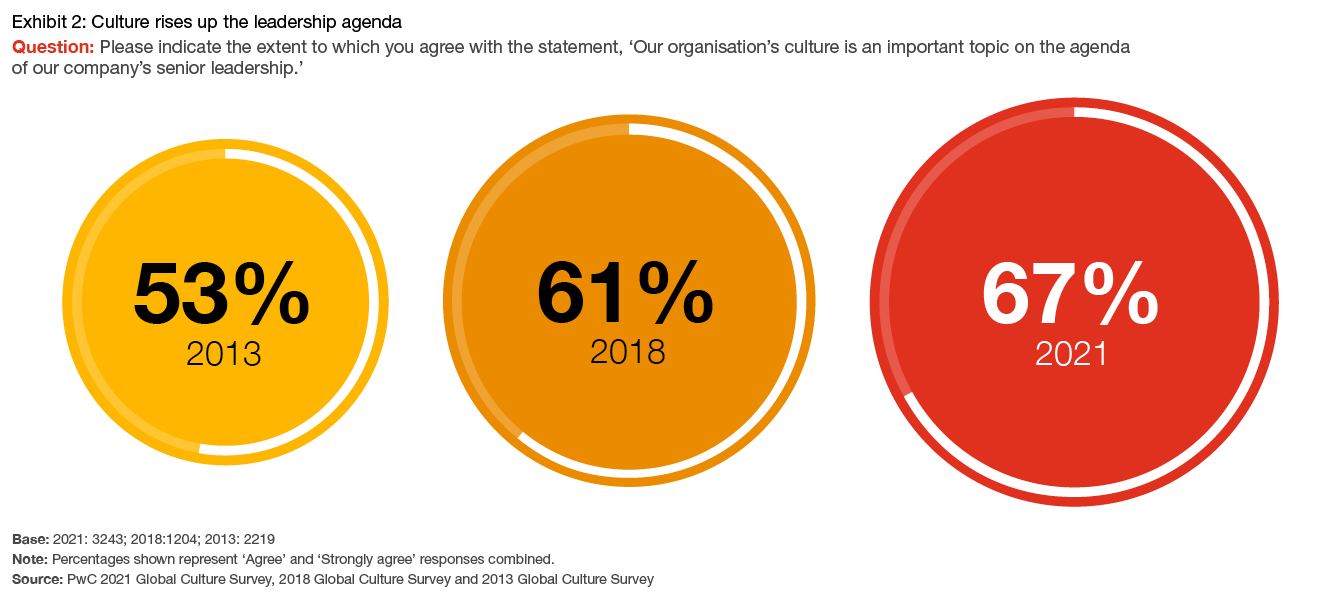
Source: Google Ngram search of ‘culture’ in Wall Street Journal and Forbes, 2001–21
But our survey also reveals that talking about culture and thinking culture is important don’t always translate to employees feeling a cultural impact. For instance, there is an average 20-percentage-point gap between managers and nonmanagers in a series of questions we asked related to how well their company supports diversity, equity and inclusion (DEI) efforts.
To fully reap the benefits of a strong organisational culture, leaders need to close this gap. And they’ll probably need to work with policymakers who can lay the foundation—for example, with policies that encourage flexibility and protections for workers and deliver on what leaders say they want their culture to represent. The reasons for doing so are numerous, and were highlighted by the pandemic, when the role of culture in companies’ ability to adapt, team, be productive and exhibit care for their employees and customers was on full display. But the evidence of culture’s effect is more than anecdotal. Our survey data bears out the connection between an organisation having a strong culture and also having business success.
The evidence that culture is a competitive advantage
The results from our survey are resounding: 81% of respondents who strongly believe their organisation was able to adapt during the 12 months before our survey was conducted also say their culture has been a source of competitive advantage (see Exhibit 4). These results are consistent across geographies, and the percentage is even higher in some countries, with 80% saying so in the US, 94% in China, 92% in India and 72% in the UK. Among respondents in senior management positions, 72% agree that their culture helps successful change initiatives happen. And respondents who say that their organisation has a distinctive culture and that culture is an important topic on the leadership agenda also were more likely to say that revenue, employee satisfaction and customer satisfaction increased during the pandemic (see Exhibit 5).
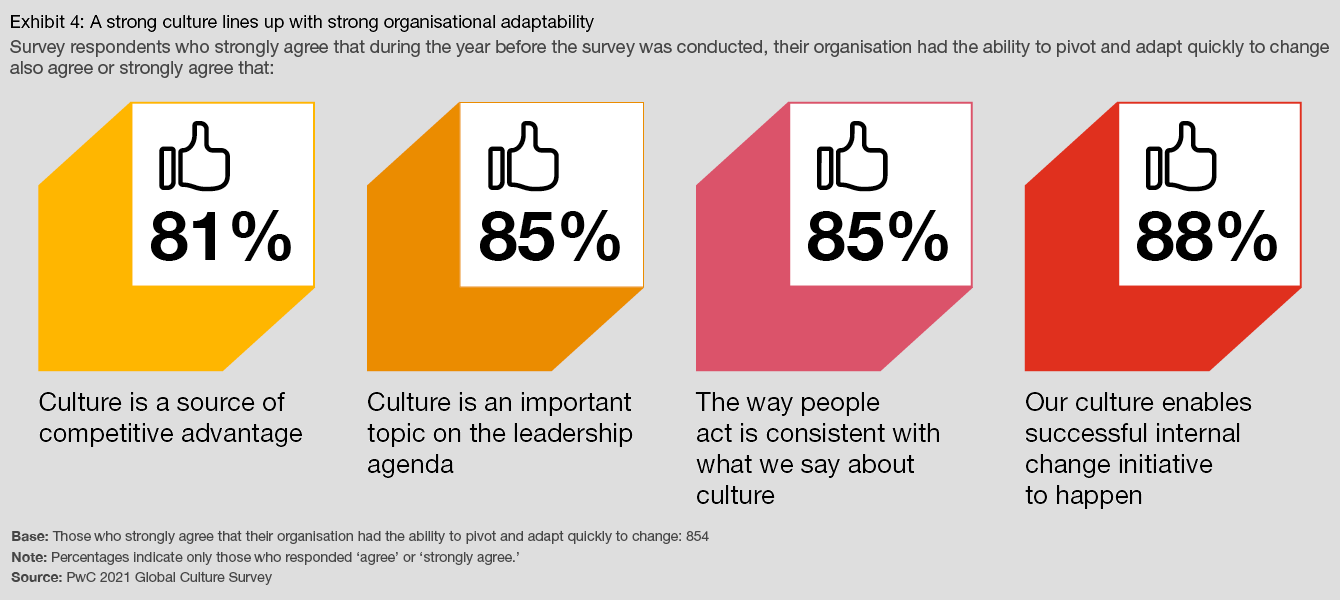
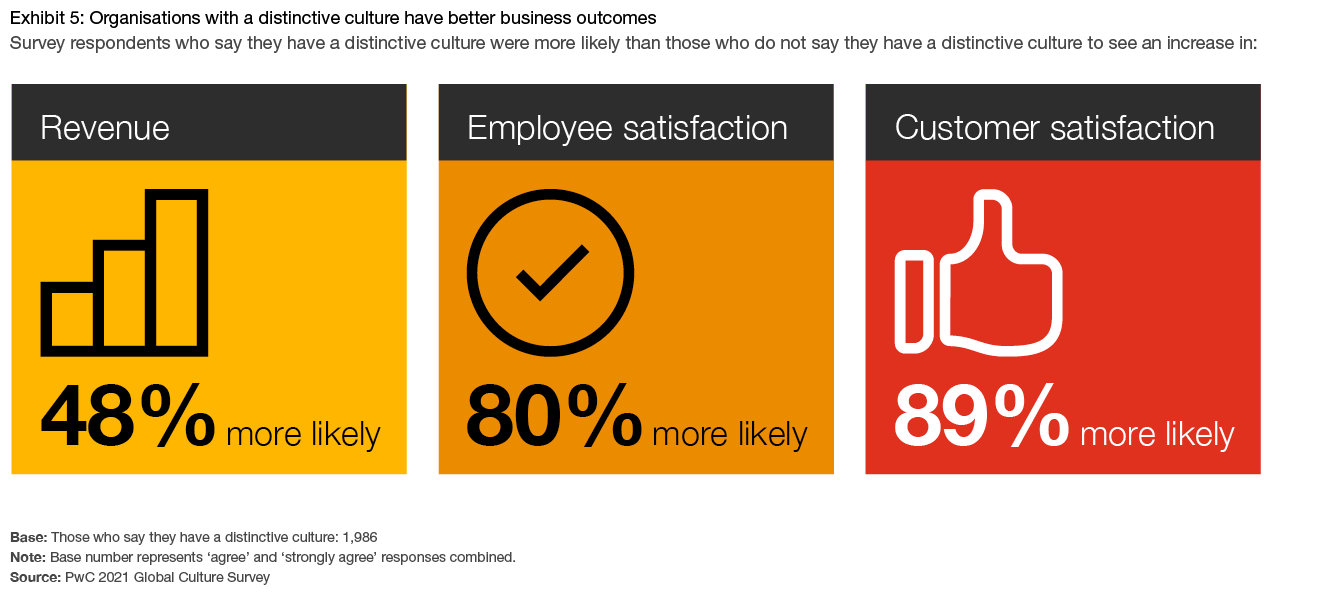
It’s also clear from our survey that organisations with a distinctive culture found it easier to maintain performance and pivot if needed during the crisis. Of these organisations, 73% say that making decisions quickly became easier (or stayed the same) during the pandemic, 64% say that collaborating with colleagues was easier or the same as before, and 66% say that responding to customer needs was easier or stayed the same (see Exhibit 6). These trends largely hold across geographies, with some differences. Notably, respondents in China didn’t see the same difference in their ability to meet customer needs, those in the US didn’t see the same difference in their ability to innovate, and those in India didn’t see the same difference in their ability to coach and develop.
Base: Those who say they have a distinctive culture: 1,986
Those who say they do not have a distinctive culture: 411
Note: Base number represents ‘agree’ and ‘strongly agree’ responses combined
Source: PwC 2021 Global Culture Survey
On the flip side, our survey shows that when culture is not a priority, certain ways of working are not as easy or successful as when culture is prioritised. This perspective is important as leaders think about recruiting and retaining the best talent, which is key to creating and maintaining a competitive advantage.
We at PwC have spent a great deal of time exploring workforce and employer needs related to remote work and hybrid models. It will be critical for organisations to strike a balance between differing needs and the old and new ways of doing things. Of those we surveyed who worked from home during the pandemic, 44% say that it became more difficult to maintain a sense of community with their colleagues, compared with 33% of those who continued to go to a workplace. Just one in ten (12%) of all respondents say coaching and development became easier, and two-fifths (41%) say it became more difficult. As more organisations shift towards a hybrid working model, pressure will be put on certain aspects of culture. For instance, it might be harder for employees to feel connected to the organisation and each other, or issues of inequity might be exacerbated.
Recognising these facts about the competitive advantage—or disadvantage—that culture can create doesn’t mean that leaders will know how to capitalise on its potential power. In the coming months, as organisations and people adapt to very different working conditions, the value of culture will be tested once again. How can leaders make sure they have a distinctive culture that sets them apart from competitors? And what might undermine their efforts to improve recruitment and retention and other strategic objectives? The survey identifies significant cultural challenges that need to be addressed.
Cultural incoherence—the authenticity gap
For example, the level of connection that employees feel to the company, its purpose and one another influences their emotions. And positive emotions energise effort and enable change and adaptability. Our survey shows that sincere leadership and cultural cohesion are aligned with higher levels of connectivity (see Exhibit 7).
Base: All respondents: 3,243
Note: To create this 'connectivity index,' we correlated the following four statements with other aspects of organisational culture: 'I feel a personal connection to our organisation's purpose,' 'I believe I have the right skills to be successful in our organisation,' 'Our team members motivate and inspire me to do my best work,' and 'I feel I can be my whole ("authentic") self in our organisation.'
Source: PwC 2021 Global Culture Survey
Our survey also shows that the positive impact of culture is felt most strongly in organisations in which the entire workforce sees their leaders acting in authentic ways. Of respondents in our survey who say that their organisation’s leaders are ‘role models of value, purpose and culture,’ 83% also say that culture was a source of competitive advantage during the pandemic, and 83% say that their organisation’s culture enabled change initiatives to happen.
These findings point to an enduring challenge for leaders: how to translate the talk about culture into actions that are felt every day at all levels of the organisation.
In 2018, we highlighted a gulf between C-suite and board members’ perception of their organisation’s culture and the experience of their people. In our work with clients, we’ve seen that this incoherence between what leaders say they want the culture to be and how workers experience it has a detrimental impact on one very important emotion—trust. Without trust, it becomes much more difficult to bring about change, motivate people and encourage the right behaviours within the organisation.
This year’s survey shows that this chasm between leaders’ and employees’ perceptions persists, extending to almost every element of culture (see Exhibit 8). This gap creates a huge barrier to realising the benefits of investing in culture.
Base: C-Suite/board: 382. Below management: 926
Source: PwC 2021 Global Culture Survey
At the heart of this mismatch is the issue of authenticity; business leaders believe they are a walking embodiment of the organisation’s culture, values and purpose, but their employees disagree. Closing these gaps in perception and authenticity is essential, because authenticity is correlated with not just good feelings but also measurable business outcomes.
One of the starkest gaps between employees and leaders in our survey shows up in questions pertaining to DEI. Only 21% of respondents overall say that DEI needs to be improved in their organisation, and there is a huge mismatch between the views of leaders and below-management employees (see Exhibit 9). This gap persists across all geographies.
Base: C-Suite/board: 382. Below management: 926
Note: Percentages represent ‘agree’ and ‘strongly agree’ responses combined
Source: PwC 2021 Global Culture Survey
Our data shows that many workers today feel they’re not fully seen or heard and that their workplaces aren’t as inclusive as leaders think they are. This has consequences. Some who don’t feel that they can be their authentic selves at work may resort to code-switching—adjusting their behaviour, expressions or speech patterns in order to fit in or because they think they’ll be treated more fairly and given more opportunities as a result. And this risk might be exacerbated further in the future hybrid model of work. Employees who are uncomfortable are unlikely to stay for long. Unless this issue of workers not feeling included or seen is addressed, and DEI values are genuinely embedded into culture, an organisation will struggle to retain the talent it needs.
Our analysis confirms that consistency matters, not just in leaders’ talk and actions, but in the behaviours of people across the organisation. We call this cultural coherence. Survey respondents at organisations where there is consistency between what is said about culture and the way people behave fare considerably better in terms of revenue and employee and customer satisfaction (see Exhibit 10).
There is evidence that a lack of cultural consistency in organisations is causing another fundamental problem. Our survey this year shows that employees are losing faith in the power of culture: although the number of C-suite and board members who believe that culture is more important than strategy or operating model has increased, the number of frontline workers who say the same has gone down since our 2018 survey, from 66% then to 46% this year.
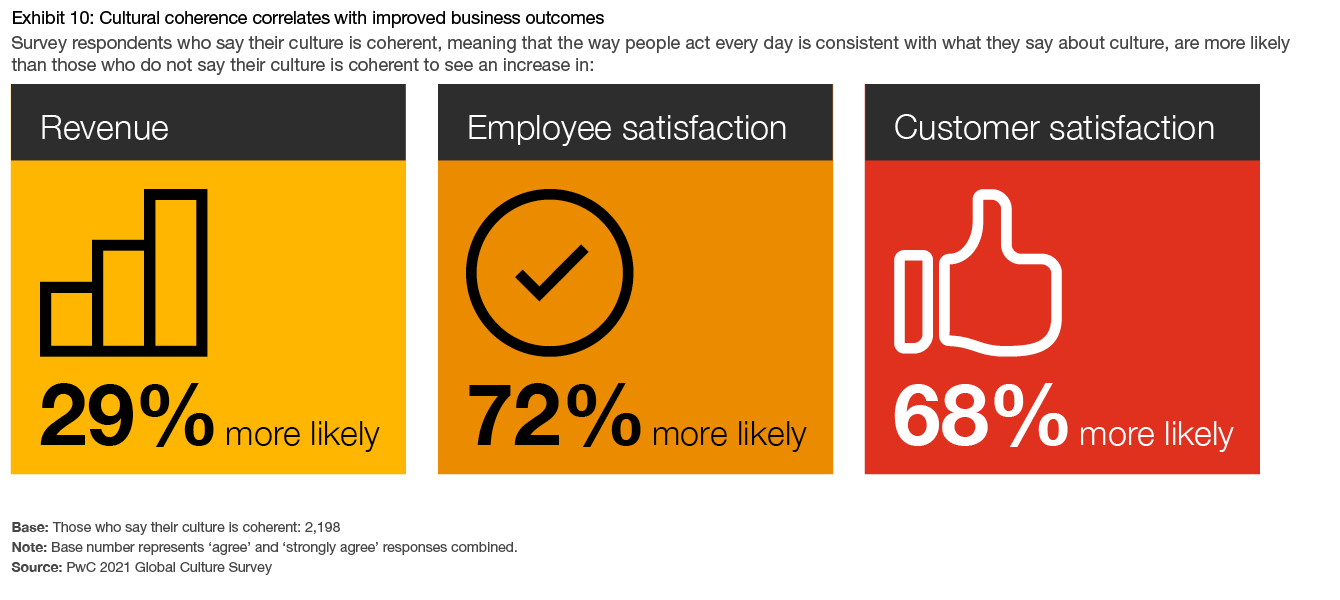
The solution: Purposeful management of culture
Organisations that have clarity and alignment on what it is they hope organisational culture will help them achieve are in a better position to tap into the power of culture. Understanding culture—and the levers that can be pulled to affect it—begins with taking inventory of the traits that people use to describe it and the behaviours that people habitually follow.
Our survey data shows that the qualities or traits that organisations want to embed in their culture have remained fairly consistent over time, with a few exceptions. Digitisation and health and safety have entered leaders’ top five cultural priorities, replacing agility and customer-centricity. PwC’s 24th Annual Global CEO survey also shows digitisation among executives’ top five priorities, and a PwC US survey reveals the emphasis leaders are putting on employees’ well-being—so these trends are probably here to stay. This year, leaders once again identified recruitment and retention as the cultural priority they most need to improve (see Exhibit 11). But for companies that respondents say have not exhibited the ability to pivot and adapt through COVID-19, the need for improvement was even greater: 45%, compared with 37% that have had the ability. In addition, collaboration was a much greater need in organisations that respondents say did not adapt well to COVID-19: 41%, compared with 31% that have had the ability (see Exhibit 12).
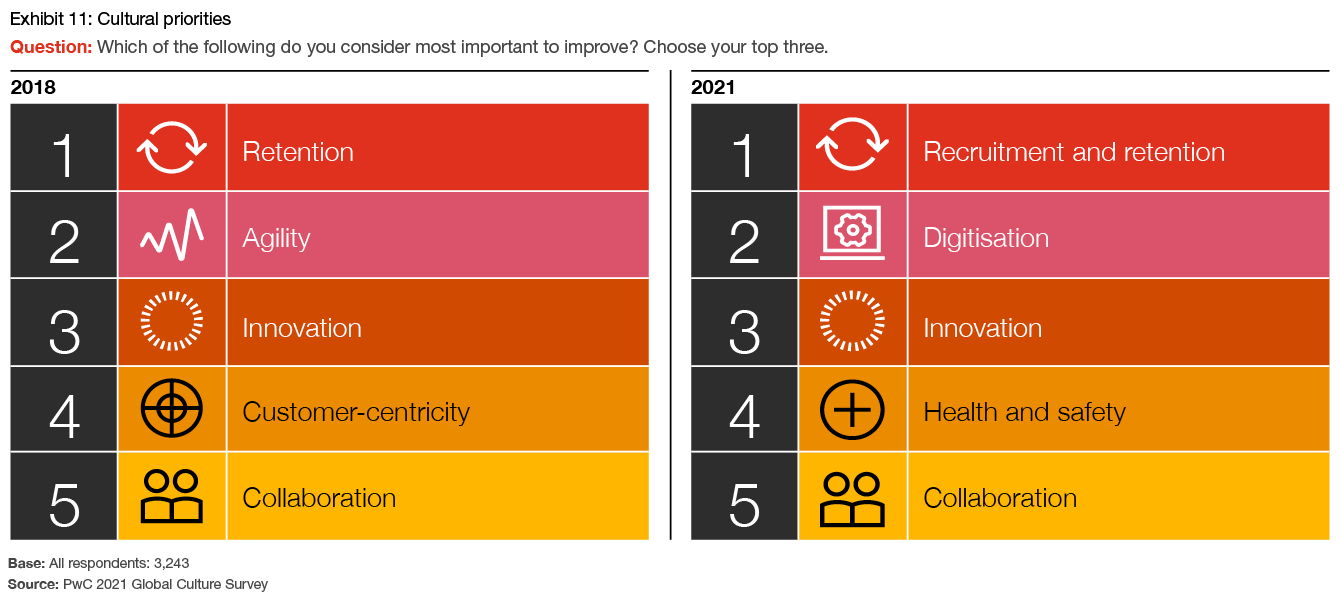
Base: Those who say their organisation had the ability to pivot and adapt quickly to change: 2,515. Those who say their organisation did not have the ability to pivot and adapt quickly to change: 283
Note: Base numbers in relation to pivoting and adapting quickly to change represent ‘agree’ and ‘strongly agree’ responses combined, and ‘disagree’ and ‘strongly disagree’ responses combined
Source: PwC 2021 Global Culture Survey
But organisations might not understand which cultural traits and behaviours correlate closely with those goals. For example, by asking respondents to identify points along a scale that best describe their organisation’s dominant traits (see Exhibit 13), we can conclude that a majority of those taking part in the survey say their organisations are hierarchical. But according to our analysis of these findings about cultural traits, along with survey respondents’ answers to questions about what areas of their business they need to improve, we can see that being non-hierarchical correlates with better recruitment and retention. There are some regional variations in dominant cultural traits. For instance, respondents in China were more likely than the global average to say their organisations make decisions via consensus (61% versus 45%). Respondents in Germany were less likely than the global average to say this (30%). And respondents in Australia were more likely to say their organisations pursue revolutionary change versus incremental change (40%), compared with the global average (30%).
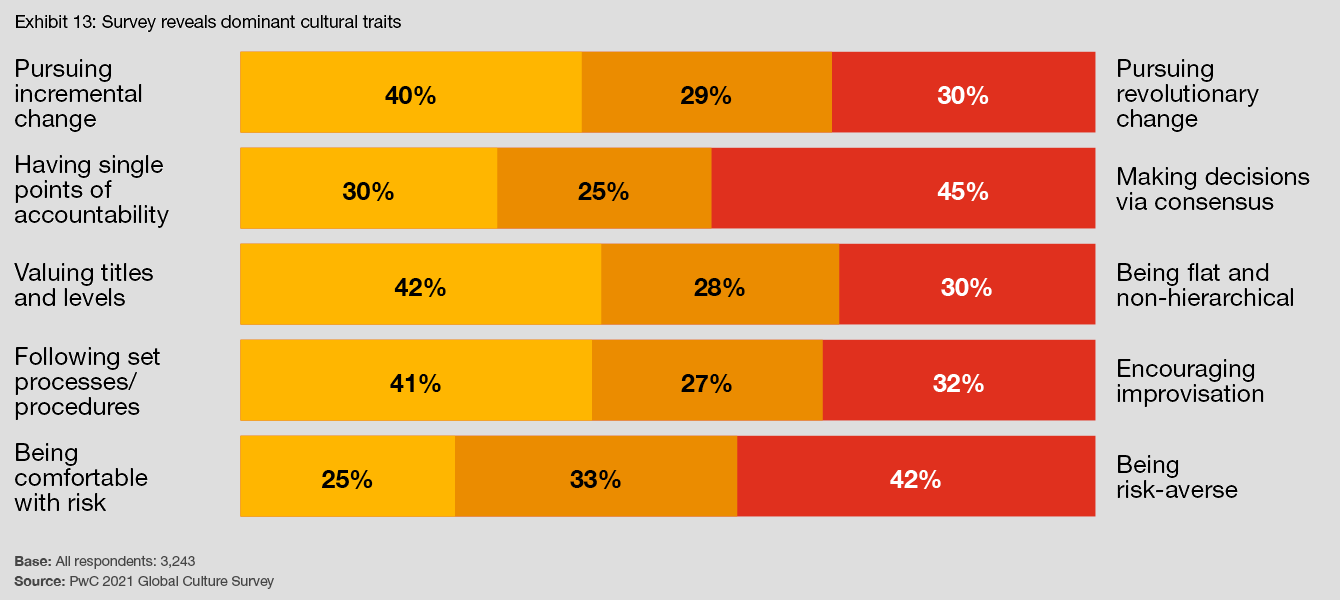
Leaders juggling multiple strategic priorities might have to perform a delicate balancing act if those priorities are supported by opposing cultural traits. For example, we noticed in our analysis that organisations that say they need to improve recruitment and retention also say that some of their cultural traits are making decisions via single points of accountability and embracing an incremental approach to change. What this implies is that these two traits might be undermining recruitment and retention efforts. But before jumping to conclusions, it’s important to acknowledge that those same traits might actually help with other parts of an organisation’s strategy. For example, in the 2018 Global Culture Survey, we saw that having single points of accountability is a good thing if a company is striving for operational excellence.
If organisations are to navigate the challenges ahead, their chances will be greatly improved if they can first identify and prioritise their strategic goals, then understand which traits and behaviours support those goals, and then activate and begin to evolve their culture by using key organisational levers, or enablers.
Our survey presented participants with nine enablers—both formal and informal—that we know from experience are effective in helping organisations create coherence in the traits and behaviours they’ve identified as most important to their success.
Our analysis of survey results also confirmed that organisations should use as many of these enablers as possible, whether formal or informal. Our analysis shows that organisations with more distinctive cultures and those with more coherence activate more of these culture change enablers. For example, when more than four enablers were activated during the pandemic, the survey results showed a significant rise in culture being a source of competitive advantage and in an organisation’s ability to adapt (see Exhibit 14).
Exhibit 14: The more culture enablers activated, the stronger the culture
| Culture enablers | 0 present | 1-3 present | 4-7 present | 8-9 present |
| We have a distinctive culture which sets us apart from our competitors | 26 | 39 | 61 | 84 |
| Our organisation's culture is an important topic on the agenda of our company's senior leadership | 23 | 41 | 70 | 90 |
| The way people act every day in our organisation is consistent with what we like to say about our culture | 28 | 43 | 69 | 91 |
| In order to succeed, grow, and retain the best people, our organisation's culture will need to evolve significantly in the next three to five years | 57 | 68 | 70 | 78 |
| Our organisation's culture has been a source of competitive advantage thorughout the COVID-19 pandemic | 23 | 39 | 73 | 91 |
| Our culture enables successful internal change initiatives to happen | 21 | 34 | 70 | 92 |
| Over the past year, our organisation has had the ability to adapt quickly to respond to change as necessary | 35 | 56 | 83 | 96 |
| In general, culture is more important to performance than an organisation's strategy or operating model | 30 | 40 | 55 | 71 |
Base: All respondents: 3,243. 0 present: 257. 1-3 present: 709. 4-7 present: 1,180. 8-9 present: 1,097
Source: PwC 2021 Global Culture Survey
Organisations using more of these enablers were also more likely to see improvement in key performance indicators, including revenue, customer satisfaction and employee satisfaction, during the pandemic (see Exhibit 15).
Base: All respondents: 3,243. 0 present: 257. 1-3 present: 709. 4-7 present: 1,180. 8-9 present: 1,097
Source: PwC 2021 Global Culture Survey
In other words, an actively managed culture provides people with the reinforcing nudges and support to create momentum around the critical few behaviours that support business success.
Culture as a catalyst
We have seen that an organisation’s culture is deeply rooted and slow to evolve. But 2020 showed that when necessary, organisations can achieve rapid changes with a targeted focus on a critical few behaviours. Going forwards, as leaders take on a long list of business imperatives, such as digital transformation and adapting to changing working practices, organisational culture can be a powerful ally.
Of course, there’s still work to be done if organisations are to translate leaders’ good intentions on culture into measurable gains in employee retention, DEI and transformation initiatives. But when aligned with strategy, purpose and the operating model, culture can be a powerful force that supports retention and acts as an insurance policy against future crises.
Methodology
The Global Culture Survey was conducted online March 1–26, 2021. A business panel was used across 15 countries (Australia, Canada, China, France, Germany, India, Japan, Malaysia, the Netherlands, Russia, Singapore, South Africa, Switzerland, the UK and the US). Participants from these and other territories were also invited to complete the survey through a registration process. In total, 3,243 surveys were completed from 42 countries.
Contact us


















